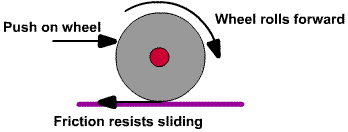First and foremost, here is the free body diagram of the wheel. The wheel is moving to the left and the friction is holding it back in the opposite direction. The $c$ here is damping from the bearing of the wheel, but I am not going to explain that further because we are focusing on the friction between the wheel and the ground.

From the free body diagram, the friction is only written as $F_t$, mainly because there are two types of frictional force, and they both play a role here. The static frictional force $f_s$ and the kinetic frictional force $f_k$ can be written as
$$f_s = \mu_s N \\
f_k = \mu_k N $$
where $\mu_s$ & $\mu_k$ are static and kinetic friction coefficient respectively and $N$ is the normal force.
Now, if we try to move a block of wood from a stationary position by applying a force to it, the friction force is not constant. It follows the diagram below

(source: ucsc.edu)
So, we start with not enough force to move the wooden block, what we feel is actually the static frictional force holding back our applied force. Without this, then the block would move with just a tiny amount of force (marked red). Next, if we apply more force, the friction holding it back will increase until a threshold point (marked green); this is at the exact moment when the block is just about to move. Then, as we apply even greater force, we will eventually move the block and the friction would remain constant even if we keep applying more force (marked blue).
Thus, in a car, we can imagine the scene as something similar to that block of wood. When moving, the engine rotates the wheel with just enough torque so that the wheel can "grip" the road using the static frictional force. Does that mean the car doesn't move? No, because the bottom of the wheel is held back by friction, therefore there is no motion relative to the two surfaces. Also, because the torque generated by the engine, it still wants to rotate. Since the bottom part doesn't move, it moves forward
On the other hand, if more torque is applied (or the surface is slippery, thus reducing the static frictional coefficient) then the wheel would slip or spin in place (e.g. when going through mud). Or simply put

I hope this answers your question. There are a lot of resources on the internet on this topic. This is just a summary based on the available information.




